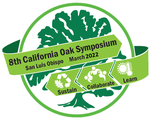#59

Marc Mayes, Earth Research Institute, University of California-Santa Barbara
Andrea Hefty, Stacy Hishinuma, Sheri Smith: US Forest Service, Pacific Southwest Region
Juan Troncoso, Hannah Walchak: The Escondido Creek Conservancy, Escondido, CA
Erin Andreatta, Isaac Ostmann, Nathan Gregory: Irvine Ranch Conservancy, Irvine, CA
Since the early 2000s, drought and insect invasions have threatened increasingly large areas of coast live oak (Quercus agrifolia) woodlands in southern California (CA). One challenge to addressing these threats has been reliable detection and differentiation of these stressors across rugged terrain to prioritize mitigation in the right places. Canopy thinning has been used as a general measure for oak woodland health in field and satellite remote sensing data over large areas. Drone imagery is a promising new resource for monitoring insect pest and drought stress, given it resolves individual tree crown and stand canopy changes at scales directly applicable to mitigation actions such as tree removal or contact insecticide spraying. However, improved understanding of (1) canopy thinning responses to stressors of concern (i.e., insects, drought), and (2) the accuracy of canopy thinning detection in drone and satellite imagery are needed to advance operational remote sensing use for conservation management.
Here, we report findings from the first year of a three-year project to advance drone-based remote sensing methods for surveillance of goldspotted oak borer (GSOB) (Agrilis auroguttatus) invasions, and evaluation of mitigation efficacy in CA coast live oak ecosystems. Our goals are to refine calibrations of drone and satellite imagery to canopy thinning, collect drone imagery over multiple years at GSOB-infested sites to monitor canopy conditions, and assess the efficacy of GSOB-mitigation actions for limiting further infestation, promoting crown health and tree recovery. We also conduct analyses of drone imagery-based metrics alongside satellite image time-series to explore differentiation of drought stress from insect invasion in coast live oak woodlands. A final aim of the project is developing partnerships among academic, public agencies and private conservancies around use of new technologies, such as drones, to expand the spatial scale and efficiency of conservation management in coast live oak woodlands.
